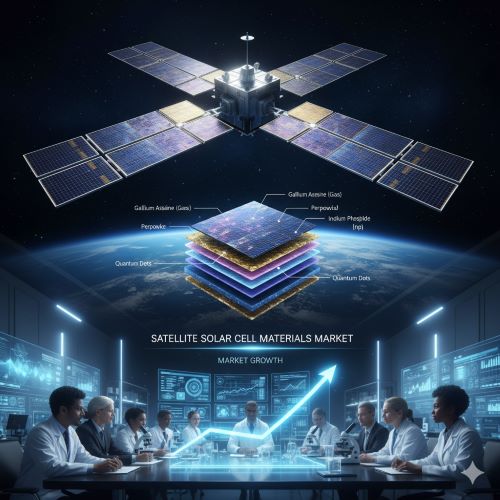Satellite Solar Cell Materials Market Projected to Grow at 13.8% CAGR Through 2031

The Global Satellite Solar Cell Materials Market was valued at US$ 44.1 million in 2023 and is projected to reach US$ 124.0 million by 2031, registering a CAGR of 13.8% during the forecast period 2024–2031.
Market growth is primarily driven by increasing demand for high-efficiency solar cells in satellites and space exploration, coupled with the rising adoption of low Earth orbit (LEO) satellite constellations, communication satellites, and space-based solar power systems. Satellite solar cell materials such as multi-junction III-V semiconductors, gallium arsenide (GaAs), thin-film solar cells, and perovskite-based cells play a critical role in maximizing energy conversion efficiency in space environments.
Technological advancements in solar cell efficiency, radiation resistance, and lightweight material design are improving satellite performance and mission lifespan. Moreover, the growing demand for space-based internet, earth observation, and scientific research satellites is fueling market adoption in both developed and emerging space-faring nations.
📌 Download Your Sample Report Instantly (Corporate Email ID required for priority access):
https://www.datamintelligence.com/download-sample/satellite-solar-cell-materials-market
Market Drivers:
The Satellite Solar Cell Materials Market is witnessing strong growth, driven by the rising demand for high-efficiency solar cells in spacecraft, satellites, and orbital platforms. Multi-junction solar cells, especially III-V compound semiconductors, are increasingly used in communication satellites, remote sensing platforms, and space exploration missions due to their superior energy conversion efficiency and durability under harsh space conditions.
-
Space Industry Expansion: The surge in LEO satellite constellations, commercial space ventures, and government space programs is fueling demand for reliable, high-performance solar cell materials.
-
Advancements in Solar Cell Technology: Innovations in lightweight, flexible, and radiation-resistant solar cells enhance satellite payload efficiency and reduce launch costs.
-
Renewable Energy in Space: Exploration of space-based solar power systems is generating interest in high-efficiency, durable solar cell materials capable of operating in extreme conditions.
-
Miniaturized Satellites (CubeSats and SmallSats): Increasing adoption of small satellites in communication, earth observation, and scientific applications is driving the need for compact and efficient solar solutions.
Market Segmentation:
By Type: Multi-junction Solar Cells, Gallium Arsenide (GaAs), Thin-Film Solar Cells, Perovskite Solar Cells. Multi-junction cells dominate due to superior efficiency and radiation resistance.
By Application: Communication Satellites, Earth Observation Satellites, Navigation Satellites, Space Exploration Missions, CubeSats/SmallSats. Communication and earth observation satellites lead global consumption.
By End User: Government Space Agencies, Commercial Satellite Operators, Research Institutions, Defense & Aerospace Companies.
By Region: North America, Europe, Asia-Pacific, Middle East & Africa, South America. North America leads high-end solar cell development and satellite manufacturing.
Key Players:
-
Spectrolab, Inc.
-
Azur Space Solar Power GmbH
-
SolAero Technologies Corp.
-
Emcore Corporation
-
SunPower Corporation
-
Boeing Spectrolab
-
Alta Devices, Inc.
-
MicroLink Devices, Inc.
Geographic Insights:
-
North America: Market growth is driven by government and commercial satellite launches, space exploration programs, and R&D in high-efficiency solar cells. The U.S. dominates due to NASA, SpaceX, and defense satellite programs.
-
Europe: Expansion supported by ESA initiatives, renewable energy satellites, and collaborative space missions. Germany, France, and the U.K. are key contributors.
-
Asia-Pacific: Fastest-growing region with large-scale satellite programs in China, Japan, and India. Government support for space exploration and private satellite startups fuels demand.
-
Middle East & Africa: Emerging adoption in communication and earth observation satellites, supported by investments in space technology infrastructure.
-
South America: Moderate growth driven by scientific satellites, earth observation projects, and regional defense initiatives.
Key Observations:
-
Multi-junction III-V solar cells dominate due to high efficiency and space resilience.
-
Asia-Pacific is emerging as a manufacturing and R&D hub for satellite solar technologies.
-
Commercial satellite constellations and CubeSats are major growth drivers.
-
Research into flexible and lightweight solar cells is expanding rapidly.
-
Government and private space programs are driving long-term market demand.
Latest Trends:
-
Development of lightweight, flexible, and radiation-resistant solar cells for next-generation satellites.
-
Integration of perovskite solar cells for cost-effective, high-efficiency solutions.
-
Expansion of CubeSat solar solutions to reduce launch costs and enhance performance.
-
Collaborations between solar cell manufacturers and satellite OEMs for mission-optimized solutions.
-
Advancements in AI and automation for solar cell quality control and performance testing.
Challenges & Restraints:
-
High production and material costs impacting overall affordability.
-
Dependence on rare and specialized semiconductor materials.
-
Technical limitations in scaling flexible or perovskite solar cells for large satellites.
-
Harsh space environment affecting solar cell longevity and performance.
-
Regulatory and geopolitical challenges in satellite deployment and material sourcing.
Market Outlook:
The Satellite Solar Cell Materials Market is poised for robust expansion as space commercialization accelerates. Rising investments in LEO constellations, defense satellites, and earth observation programs will continue to drive demand. Manufacturers are focusing on innovation in high-efficiency, lightweight, and radiation-resistant solar cells, along with sustainable material sourcing.
With North America leading in high-end applications and Asia-Pacific emerging as a production hub, the market is expected to evolve through technological collaborations, vertical integration, and recycling-driven sustainability. Satellite solar cell materials will remain fundamental in powering communication networks, space exploration, and future space-based energy systems.
Conclusion:
The Satellite Solar Cell Materials Market is a critical enabler of the modern space economy, supporting commercial, governmental, and scientific satellite missions. Despite challenges such as high costs and material dependency, innovations in multi-junction, flexible, and radiation-resistant solar cells will propel strong growth. Over the next decade, satellite solar cell materials will play a vital role in advancing space technology, enabling efficient energy generation, and supporting the rapid expansion of satellite-based infrastructure.
Contact Us:
Company Name: DataM Intelligence 4market Research LLP
Contact Person: Sai Kiran
Email: Sai.k@datamintelligence.com
Phone: +1 877 441 4866
Website: https://www.datamintelligence.com
- Art
- Causes
- Crafts
- Dance
- Drinks
- Film
- Fitness
- Food
- Games
- Gardening
- Health
- Home
- Literature
- Music
- Networking
- Other
- Party
- Religion
- Shopping
- Sports
- Theater
- Wellness


